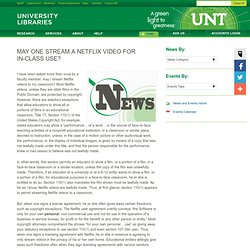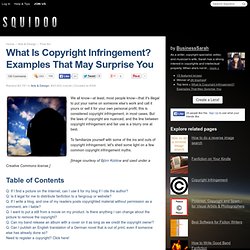

May one stream a Netflix Video for in-class use? I have been asked more than once by a faculty member, may I stream Netflix videos to my classroom?

Most Netflix videos, unless they are older films in the Public Domain, are protected by copyright. However, there are statutory exceptions that allow educators to show all or portions of films in an educational classroom. Title 17, Section 110(1) of the United States Copyright Act, for example, states educators may show a “performance… of a work… in the course of face-to-face teaching activities of a nonprofit educational institution, in a classroom or similar place devoted to instruction, unless, in the case of a motion picture or other audiovisual work, the performance, or the display of individual images, is given by means of a copy that was not lawfully made under this title, and that the person responsible for the performance knew or had reason to believe was not lawfully made.
What if you invite your class over to your house and stream a movie for educational purposes? Teaching Copyright. TeacherCopyright_chart.pdf. A Copyright-Friendly Toolkit. However fabulous Creative Commons and Public Domain content may be, sometimes you really need to use copyrighted material.
Say you plan to comment on popular media or current events. For instance, you may be planning to critique the portrayal of Native Americans in commercial films. You are going to want to “quote” some commercial films like Pocahontas, Lone Ranger, and Dances with Wolves. If you are reviewing a book, you may want to share its cover art. You may use copyrighted content without asking permission if you believe that your use falls under the doctrine known as Fair Use.
In general, when you transform original content, repurpose it, and add value to it in your own remix, you may be able to claim the use fair. According to American University’s Center for Media and Social Impact, these two tests or questions help you plan whether to use the copyrighted work of others without asking permission: The video below explains why the Code for Fair Use in Online Video was created. Copyright Crash Course. The Copyright Crash Course was created by Georgia Harper and is currently maintained by UT Libraries.

The Course is arranged into several sections that allow users to explore certain areas of copyright law individually or as a group. The Course was originally created with faculty in mind, but can be used by anyone who is interested in understanding and managing their copyrights. If you need to take the Crash Course tutorial & test, click here (UT affiliation required). Version 1 of the Copyright Crash Course is available via Texas ScholarWorks. You are using Version 2. This work is licensed under a Creative Commons Attribution 4.0 International License. What Is Copyright Infringement? Examples That May Surprise You.
There are a few things going on here.

First of all, let’s forget about the existing translation and look back at the definition of a derivative work from the first question. It’s pretty clear that without the original book, there could be no translation whatsoever—the de facto definition of “derivative.” The Code of Best Practices in Fair Use for Media Literacy Education. Click here to view or download a PDF of this report.

Coordinated by: The Media Education Lab,Temple UniversityThe Program on Information Justice and Intellectual Property,American University Washington College of LawThe Center for Media & Social Impact,American University With funding from: The John D. and Catherine T. MacArthur Foundation And additional support from: The Ford Foundation,by way of the Future of Public Media Project Introduction Principles of Fair Use in Media Literacy Education 1. 2. 3. CodeofBestPracticesinFairUse_0.pdf. The Anti Plagiarism Game Show Cite is Right!
A Fair(y) Use Tale. Copyright Awareness for Students (3 minute video) Creative Commons. Copyright Office Classroom Experiment. Jsd2libraries / FrontPage. Media Tools (file conversion tools, photo, video, audio sources & editing tools, drawing tools, image generator tools, charts and graphing tools, word cloud creators, fonts) - eBook & Audiobook Resources (online and downloadable digital content and tools to create and post your own ebooks and digital content) - iPad & Mobile Device Resources Production Tools (web-based utilities, web-based presentation & digital storytelling applications) Research Databases (links to databases, resources for teaching the databases) Search Tools & Strategies, Website Evaluation (search engines, directories; tools for teaching about electronic searching and website evaluation, educational video sources) Too Great to Miss (web-based resources and digital content)

The Teacher Tap: Professional Development Resources for Educators. Extra-large medium : A Visual Representation of Bloom’s Taxonomic... 02.10.copyright_chart (2p.sprd) 1. What's Copyright? Music Video.